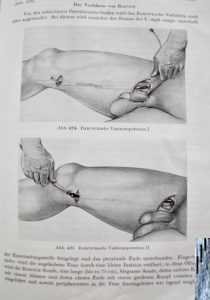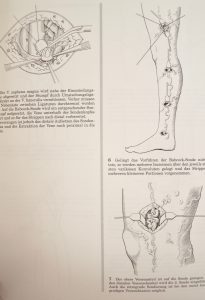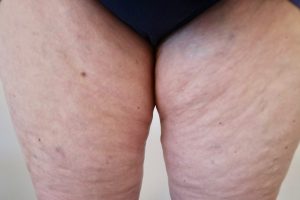Varicose veins: therapy in obesity
Varicose veins: therapy in obesity – which procedures should be recommended?
Are there – as in recent several times in advertising announcements of clinics or – in medical articles of surgical colleagues touted – a return to the 110 years performed radical surgical treatment (stripping)?
Or have the modern catheterization methods (radio wave, venous adhesive, laser, etc.) in clinical use for more than 18 years become a better, more effective, gentler alternative?
Stripping of truncal varicose veins: cosmetically good, few complications?
This impression is gained as a specialist in the field of vascular surgeon in the perception of so many advertisements in German newspapers, in the subway advertising TV and on tram posters. Or one finds publications in renowned journals on varicose veins: Therapy in the obesity. And I admit – I have to shake my head twice when I read that stripping is presented as the method of choice for the treatment of varicose veins in the obese patient.
https://www.thieme-connect.com/products/ejournals/abstract/10.12687/phleb2415-2-2018
In the following video the surgical technique of stripping is shown – about 10 cm large incisions in the groin and several skin incisions in the vein course are necessary to perform this Op effectively and properly.
However, especially in the case of surgery in adipose tissue, the proposition states that skin incisions must become larger, that the risk of bleeding increases, that the risk of injuries to sensitive nerves and small lymphatic vessels is markedly higher. Wound infections and wound healing disorders are also common in adipose tissue.


In addition also the schemata of the op technique from a surgery book from 1958 (left) and 1992 (right) – can you recognize a technical difference? No!
Although the instruments have become finer, although one usually no longer is stripping out the complete veins (stadia-adapted stripping).
Nevertheless, when pulled out of the tissue, all kinds of anatomical structures are destroyed in an uncontrolled manner.
No surgeon would today volunteer to offer an obese patient a gallbladder op with large incisions, no hernia – op, no cecal op is usually still openly treated surgically. In general, the less invasive, the better. Therefore, almost all surgical disciplines of surgery, gynecology and urology endoscopic procedures are used. Why should the radical surgical withdrawal still be the treatment of choice, especially in the treatment of the varicose vein in obesity?
Minimally invasive catheter therapy of varicose veins for 18 years
Since nearly 2000 catheter-assisted procedures have been introduced in the treatment of stem varicosis – radio wave, laser, superheated steam, venous adhesives. In the meantime long-term results are available for this – for the radio wave and the venous adhesive an effectiveness has been proven also with caliber-stabbed veins> 1.5 cm diameter. No reason, therefore, to treat the obese patient with the radical technique. On the contrary, the catheter procedures offer considerable advantages for this group of patients, considering the side effects and complications of radical surgical techniques.
Especially in obesity catheter procedures has advantages
Based on our nearly 18 years of experience with the various catheter procedures and the experience of over 10 000 radical surgery stripping treatments between 1995 and 2012, we have chosen Saphenion to refrain from radical surgical surgery whenever possible. And this applies precisely and especially for the obesity patient.

Patienten with obesity 3 days after VenaSeal therapy both legs, GSV and VSAA
Links:
https://www.thieme-connect.com/products/ejournals/abstract/10.12687/phleb2415-2-2018
https://www.ncbi.nlm.nih.gov/pubmed/28357467
https://www.ncbi.nlm.nih.gov/pubmed/27178403
https://www.ncbi.nlm.nih.gov/pubmed/26946896
http://journals.sagepub.com/doi/full/10.1177/0268355516649333
https://link.springer.com/article/10.1007/s001040050611
https://link.springer.com/article/10.1007/s00104-003-0813-5
https://www.thieme-connect.com/products/ejournals/abstract/10.1055/s-0037-1621568
https://www.thieme-connect.com/products/ejournals/abstract/10.12687/phleb2414-2-2018
K.Kremer, Volker Schumpelick, Günther Hierholzer: Chirurgische Operationen; G.Thieme Verlag, Stuttgart, New York, 1992
Chirurgische Operationslehre, 7. Auflage, Band VI, J. Ambrosius Barth Verlag, Leipzig 1958
